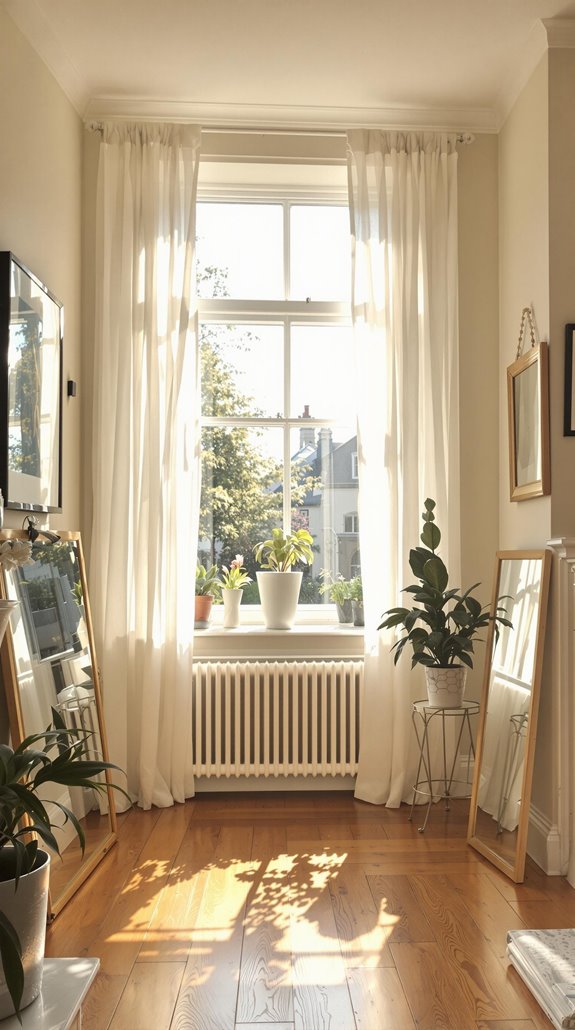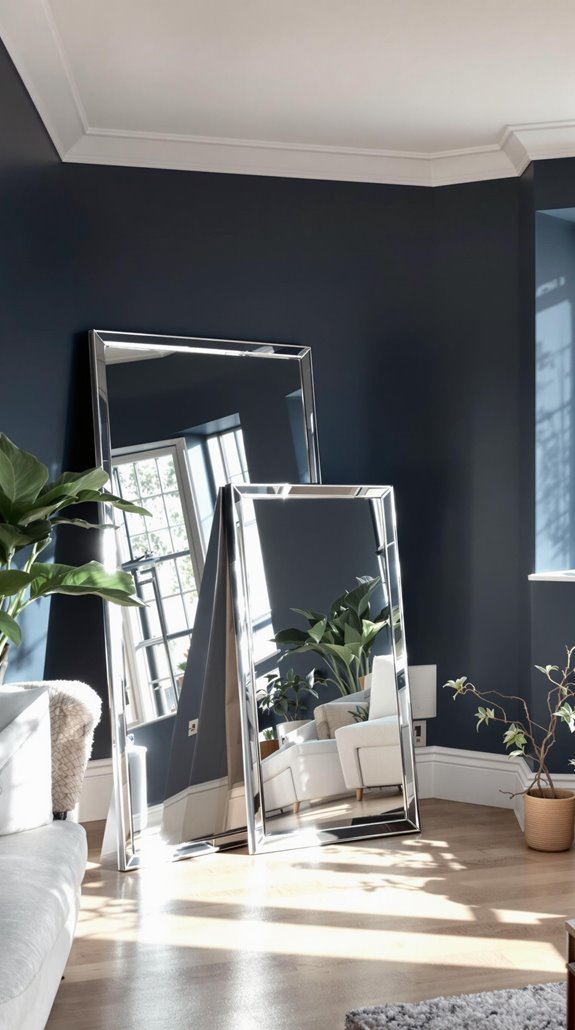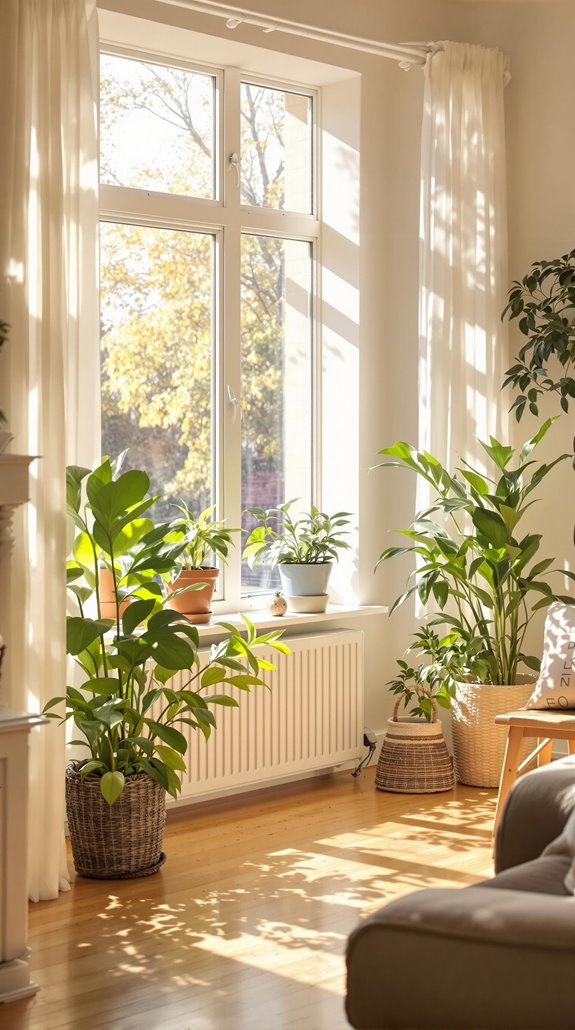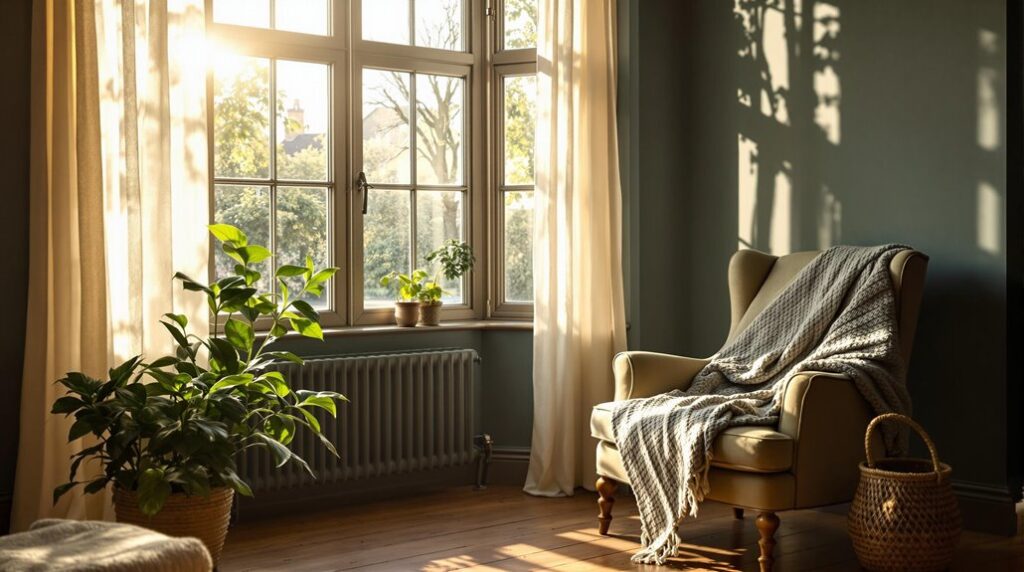I’ve worked with countless UK homeowners who’ve struggled with dark, gloomy interiors that drain energy and dampen moods. The challenge isn’t just about aesthetics—it’s about creating spaces that support your wellbeing during those long winter months. While you can’t change Britain’s cloudy climate, you can transform how light moves through your home using proven architectural techniques and strategic design choices that I’ll walk you through.
Key Takeaways
- Install rooflights or skylights facing south to achieve three times more natural light than standard windows.
- Replace solid exterior doors with glazed French doors and upgrade to larger, floor-to-ceiling windows where possible.
- Position mirrors opposite windows and use light-colored paint with satin finishes to reflect and amplify existing daylight.
- Create light wells with reflective materials to channel daylight into windowless interiors, increasing brightness by 40%.
- Remove interior walls to create open floor plans that allow seamless light flow throughout the home.
Understanding Why UK Homes Struggle With Natural Light

While most homeowners assume their dim interiors result from Britain’s notoriously cloudy weather, the reality runs much deeper into our architectural DNA. The Window Tax from 1696-1851 fundamentally shaped how we build homes, creating a cultural acceptance of minimal windows that persists today. I’ve seen countless Georgian and Victorian properties with bricked-up “blind windows” – a legacy of tax avoidance that normalized dark interiors. Additionally, planning permissions play a crucial role in determining window sizes and placements, which can further restrict natural light.
Modern building regulations compound this challenge. Current standards mandate 1.1m minimum window heights, restricting floor-to-ceiling glazing options that could maximize light. Energy efficiency requirements prioritize insulation over light transmission, while developers favor smaller windows to cut costs by 15-30%. Safety regulations further restrict upper-floor window designs, preventing the expansive glazing that could transform dark spaces. The result? We’re living with architectural decisions made centuries ago, trapped in homes designed for dimness rather than well-being.
Structural Solutions to Maximize Daylight Entry
Once you understand the architectural barriers constraining UK homes, you can tackle them with strategic structural interventions that work with our climate rather than against it. I’ll start with rooflights – they’re your most powerful tool for illuminating central areas that vertical windows can’t reach. Fixed frameless designs maximize light penetration, particularly essential for basements and extensions. Implementing creative design concepts can further enhance the aesthetic appeal while improving functionality.
Clerestory windows positioned high along walls deliver deep-room diffusion while maintaining privacy. They’re perfect for terraced homes where you need light in room cores. I’ve seen them reduce artificial lighting dependency by 30-50% in well-designed layouts.
For challenging spaces like Victorian terraces, light wells channel diffused daylight to windowless interiors. Line them with reflective materials to amplify brightness by 40%. Modern translucent facade systems can achieve insulation levels comparable to solid walls while still allowing natural light penetration.
Reflective Techniques to Amplify Existing Light

Beyond structural modifications, three simple reflective strategies can double your existing daylight penetration without major renovation costs.
First, I’ll position mirrors directly opposite windows to bounce natural light into darker corners. Oversized mirrors work best—they’ll create an illusion of space while maximizing reflection. I’ll also place mirrors on adjacent walls to redirect light deeper into my home’s interior.
Second, I’ll switch to light-colored paint with satin or semi-gloss sheens instead of matte finishes. White, cream, and pastels on walls and ceilings reflect considerably more light than darker colors, which absorb precious daylight. These reflective surfaces also help reduce energy bills by decreasing reliance on artificial lighting during daylight hours. Choosing light-colored flooring can further enhance the effect by amplifying brightness as well.
Third, I’ll incorporate glossy materials strategically—glass tabletops, metallic décor, and polished flooring all scatter light upward and throughout rooms, amplifying what’s already there.
Strategic Renovations for Maximum Light Gain
When reflective techniques reach their limits, structural renovations offer the most dramatic improvements for light-starved UK homes. I’ll guide you through the most effective structural changes that’ll transform your space.
Window Replacement and Enlargement
Upgrading to larger windows creates the biggest impact. Replace small, outdated windows with floor-to-ceiling versions where possible. Consider extending window width rather than just height – this captures more daylight throughout the day.
Glass Door Installation
Replace solid exterior doors with glazed alternatives. French doors or sliding glass panels flood adjacent rooms with natural light while maintaining security. Open floor plans allow seamless light flow by removing interior walls.
Skylight Installation
Roof windows deliver three times more light than vertical windows. Position them facing south for maximum brightness, though north-facing skylights provide consistent, glare-free illumination perfect for workspaces.
Health and Economic Benefits of Better Home Lighting

While structural renovations require significant investment, the health and economic returns from improved natural lighting far exceed the initial costs. I’ve found that proper daylight exposure reduces depression risk by 40% and cuts fall incidents among elderly residents by 50%. You’ll experience better sleep quality—office workers report 30% improvement with adequate natural light. The productivity gains are substantial: well-lit environments reduce cognitive fatigue by 25% and decrease sick days by 20%. Additionally, energy efficiency measures can further enhance the benefits of natural light by minimizing energy waste.
Financially, you’re looking at impressive returns. Energy savings from daylight utilization cut lighting costs by 40%, while healthcare expenses drop 18% due to fewer vitamin D deficiency treatments. Your property value increases 7-12% with ample natural light. Natural light exposure helps your skin absorb vitamin D, which prevents bone loss and reduces risks of heart disease and certain cancers. These productivity and health benefits typically offset renovation costs within three years, making this investment both personally rewarding and economically sound.
Conclusion
I’ve shown you proven methods to brighten your UK home naturally. Start with rooflights for maximum impact, then use mirrors and light finishes to amplify what you’ve got. Consider enlarging windows or adding glazed doors during renovations. Don’t forget clerestory windows and light wells for tricky spaces. These aren’t just aesthetic improvements—they’ll boost your mood, health, and property value. Pick the solutions that fit your budget and home’s structure, then implement them systematically.
References
- https://www.thelondoneconomic.com/property/why-do-british-homes-skimp-on-natural-light-391480/
- https://ifamagazine.com/remote-workers-productivity-suffers-from-working-in-poor-natural-light/
- https://pmc.ncbi.nlm.nih.gov/articles/PMC3072912/
- https://www.eurocell.co.uk/blog/the-hidden-cost-of-poor-natural-light-how-uk-businesses-are-losing-billions
- https://cms-group.co/considering-natural-light-in-interior-design/
- https://assets.publishing.service.gov.uk/media/5a7dbc54e5274a5eaea66049/Lighting_Report.pdf
- https://researchbriefings.files.parliament.uk/documents/CBP-9696/CBP-9696.pdf
- https://pmc.ncbi.nlm.nih.gov/articles/PMC7828303/
- https://assets.publishing.service.gov.uk/media/65705f3a739135000db03bc3/HECC-report-2023-chapter-13-solar-radiation.pdf
- https://www.kalwall.com/products/facades/

